Moss’Ari
Appearance:
Build:
From slender to muscular.
Height: (cm)
Females: 175-190
Males: 180-195
Weight: (kg)
Females: 75-120
Males: 90-125
Lifespan: (yr)
Females: 400-405
Males: 375-380
Skin:
Pale.
Hair:
Yellow to orange, rarely red or white.
Eyes:
Any greenish shade.
Language:
- HIGH-ARLINIAN
- REALMISH
Culture:
- JUNGLE
- SWAMP
- WALDER
Timeline:
-5820 D.A. Founded Moss'Ari Empire
1100 F.A. their empire collapsed
Legend
“It’s said Boriac took interest in the Archaic Neander, with whom they sired the Moss’Ari.”
Description
In the enchanting chronicle of Races, the Moss’Ari emerge—a forest-dwelling people whose lives are interwoven with the very heartbeats of nature. Cloaked in the attire of the land itself, they wear garments of plant, fibre, skin, and fur, a reflection of their connection to the earth and its bounty. Within their existence, the Moss’Ari stand as embodiments of the wilderness, embodying the harmony between the natural world and the spirit realm.
Amidst the embrace of the forest, the Moss’Ari’s presence takes root. Their attire, woven from the gifts of the land, symbolises their communion with nature. As excellent Hunters and Trackers, they navigate the intricate dance of the wilderness with expertise honed through generations. Animists, Herbalists, and Shamans converse with Spirits and whisper to the Plants, drawing upon a wellspring of wisdom that runs deep within their veins.
Their kinship with nature transcends mere existence, transforming into a profound touch that resonates through every fibre of their being. Their Settlements, whether remote and secluded or nestled in small Towns, are carefully chosen to be in harmony with the land. While farmland might be scarce, the natural Fruit and Vegetable crops that flourish nearby bear testament to their stewardship of the earth’s resources.
Hidden within the depths of the jungles and forests, their settlements, temples, and shrines stand as sanctuaries, cloaked in secrecy from all other races. These hidden enclaves are a testament to their reverence for the land, the spirits, and the ancient wisdom that has been preserved through the ages. Within these hidden realms, the Moss’Ari continue to nurture their bond with the world, an echo of the deep roots that connect them to their past and their future.
Their society thrives in small Bands or Clans, a reflection of their deep sense of community and kinship. Yet, in times of need, their unity transcends the confines of individual clans, coalescing into a presence that rivals Tribes or Hordes. When the call to defend themselves and their land resounds, the Moss’Ari paint themselves like Birch trees, their bodies becoming living canvases that echo the forest’s heartbeat. Bee– or Ant-like masks adorn their faces, symbolising the harmony between the worlds of Insects and Humans, a testament to their role as stewards of the land.
In a World where the wilderness sings its songs and the spirits whisper their wisdom, where hidden realms and the tangible world intertwine, the Moss’Ari stride forth—a symphony of nature’s essence, spirit communion, and unity with the land. With every step they take, the very leaves seem to rustle in acknowledgment, a testament to their deep connection with the wilds, the spirits, and the threads that bind them to the eternal tapestry of existence.
Skjald Yell'a'Beard
History
They were born in the Dark Ages, and as the Archaic are never counted, they are considered the second oldest of the Indigenous tribes. They are the offspring of the Boriac, who, with the blessings of Ühmrar Zänziliibûhr began to interbreed with the Neander. They did so in a Void Garden, now an integral part of the Isle of West Fjella.
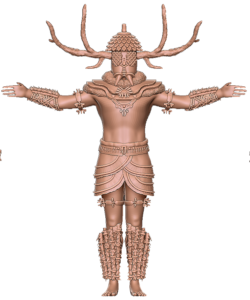
They were always strange folk and have only deviated slightly from the myths and rites of their ancestral races. They hold their heritage in high regard, and to be considered pure Moss’ari, one must have heritage lines of just their original races. If at any point some other race has mingled in, one is considered of the Common race.
They inherited a hunger for knowledge and learning from the Boriac, but the privacy and remoteness of the Archaic Neander always had the upper hand. Thus did they travel, explore, interact, and exchange, but they preferred a quiet life in secluded settlements all over the world.
Skjald Sigurd
As time passed they made numerous camps out of discovered Void Gardens, either alone or alongside Boriac and Wickeryadi. Thus they have always been close to some of the Divine Races, and hence they are Skilled Mana Manipulators. Most likely the reason there has ever been only one reported Moss’Ari Vampire.
As their skills grew and time passed, they began to study the Mana Links and Void Nodes, as these seemingly grew in volume. These early studies and interactions gave the Moss’Ari a deep understanding of what Gods are. And in some cases, their nicknames for links and nodes were the ones that the gods took as Truenames when they manifested.
Thus, even though the Moss’Ary stood close to all divine races, it came as a total surprise when their camps and settlements suddenly were relocated and well-known landscapes tossed around. Their Magic was extremely strong, so their protective seals and auras prevented them from being distributed in a single area, like most other races. Instead, Moss’Ari was spread throughout the world.
Skjald El Mary
First Age
Darkness blinded many races; among them, only the common cousins had trouble finding their way. The purebreds had excellent night vision, so they explored the world and found many interesting changes. One major change was that the Wickeryadi Void Gardens were gone, and Wickeryadi was as rare to encounter as Thursar. Yet they did find some of both and began studying Astravel in depth, as many of their former paths were now gone.
Then light suddenly came, all heads turning and staring in awe at this wonder. Down South, a gargantuan bright light suddenly rose and arched across the sky, lighting up the entire world facing it. A while later, the light seemed to sink, but a softer, pale shine took its path and illuminated the world for an equal amount of time. Then, light came back, and the pale shiner disappeared. They had just witnessed the Sun and Moon taking their first turns.
Years, decades, centuries, and millennia passed, and Moss’Ari grew in power yet never misused it. They were wise folk, unmatched in skills by any mortals, say the Mawmen. Even amongst the N-Erectus, a few stood at their side or surpassed them, and only one non-divine race, with which they generally had no dealings, surpassed them in all aspects—the vampires.
Not that there have never been interactions between Moss’Ari and vampires, but they are ultra rare. The most known are when a 1st generation vampire of Ljost Alfar origin, Zyldiliin Malthûrr, tried to embrace the Moss’Ari Priestqueen Jannari Youla de Hemoli. The embrace failed utterly, as Jannari broke the mesmerising, and a duel took place in which Zyldiliin was slain. Jannari was mortally wounded, both from the failed embrace and the duel, so she died a few months later from infection and rot. The other was, semingly a successfull embrace
Skjald Valgrif
1st Cataclysm
This embrace attempt is said to have been the spark that ignited the 1st Cataclysm. A cataclysm that ran so amok that the entire world was close to being consumed. And amidst the great duels, warring bands, and soaring astral energies, new races surged forth, strengthening both sides. At the very brink of collapse, the Vornir sang the Hymn of Truenames in an attempt to balance the forces, but by doing so, they empovered the gods greatly.
Luckily, as the true names of gods were unknown to Vornir, and they thus gained an unfair advantage. The greatest Moss’Ari shamans used their ancient knowledge and somewhat controlled the rampagning gods. Had they not been able, our world would most likely not exist.
Skjald Sejrik
Second Age
But exist World surely does… Moss’Ari lives all over… Even below The Rim… And Outlands for sure… Sessy and Yell'a'Beard have themselves seen…
Skjald Kazumix
The 1st Cataclysm had a great impact on the Rim. Almost separating the north and south hemispheres from each other is an equatorial belt of high, anti-magic mountains. Sun and Moon orbits changed, and the world tilted, so the Rim became a colder area, and the north pole became so hot that its sand is almost burning to the skin, winds are drying eyes and mouths fast, and flora and Fauna are almost extinct. The Astravel pattern was also severely damaged, as were many land areas.
So, in this reshaped world, the Moss’Ari once again had to adapt; some even relocated due to climate harshness. The abandoned sites, rich in burial artefacts and shrines, have since been the targets of Grave Robbers and Treasure Hunters. But if caught in the act of selling the loot, Moss’Ari disregards any local laws and punishes these rascals due to Moss’Ari laws. So, sellers and collectors are often extremely secretive regarding items for trade.
Very few clans ended up merging with others; most found new locations of their own. In some situations, they ended up at sites regarded as sacred by other races, resulting in conflicts of various degrees of brutality. Displaying their only flaw—a disregard for other cultures. Their stubbornness towards their own wishes has in fact resulted in situations where original residents, either by themselves or in alliances, destroyed the newly arrived Moss’Ari clan.
Skjald Ulrich
Most, though, spent the entire Second Age improving their skills, discussing lore, refining Magic Paths, and searching for the lost Herbs of the Wickeryadis Void Gardens. Thus finding quite a lot of the untainted herbs and studying their effects. Often secretly guiding other humans to the locations, so even more studies of herb effects could be done.
Aside from the few skirmishes and conflicts regarding their relocations, time passed without them making a mark in world history. The only blur to this are the rumours about a few vampire encounters, which we have been unable to confirm. Telling of Moss’Ari, who have either bested vampires or been embraced and then hunted down and destroyed by their own. But, as they are a secretive lot, none have been able to verify these hints. We do still debate this, especially after what happened regarding The Bullheaded God.
One day a large ship came sailing across the Rim, its southern origin unknown, but it aimed directly for Ljostari. As it landed on the shores, a certain Moss’Ari leader of great age departed at the very moment the bullheaded god planted its foot in the soil. The delay caused by the welcome committee of Ljost- and Drakk Alfar, Kobold, Mawmen, and Dwarves. Allowed the Moss’Ari leader to pack a waggon, drive to the shore with a large box, board a ship, and sail off to Midgard.
The bullheaded god purshued the Moss’Ari, and as we know it hunted vampires, we suspect the Moss’Ari leader to have been embraced.
The only clue we have managed to pry is that the Moss’Ari leader’s name was Ranét Ritzlouren. but there are no records, just weird tales telling of her becoming a vampire hunter. The bullheaded gods followers were allowed to create a settlement on the south shore and began constructing their new home.
A short time thereafter, several ships came to the shores as well. These did, though, only create a swift raid on the settlement, killing every Vular follower of the bullheaded god. They looted only a few items and documents and then left again, seemingly to hunt the bullheaded god. The attack was so swift that when the Ljostari defenders arrived, they were all gone. The Moss’Ari, the first at the site, announced the site a sacred place and took it upon themselves to clean up and bury the dead. The ruins stood untouched until Ljostari sank.
Skjald Sejrik
Third Age
Soon more Wanderers arrived: Rimzir, Jomzaar, and more of the Vular, who weree relatives of the followers of the bullheaded god, were slain at the Thesuvian Ruins. When the Vular found out what had occurred, they wanted to reside there, but the combined Ljostari forces supported the Moss’Ari in their sacred site claim. Thus did the Vular begin to construct another settlement across Thevuls Bay, so they could at least see the spot where the bullheaded god had landed.
The Rimzir and Jomzaar soon left again, as their shamans told of bad omens at Ljostari. Thus, the Vular had the plentitude to tell the Wanderers tale and sow seeds against Rimzir and Jomzaar, with whom they had grudges. They also pushed hard to study with and learn knowledge from the various races at Ljostari and all the other Isles. The Moss’Ari consulted the Rimzir shamans regarding their Ljostari omen visions and shortly thereafter began migrating away from Ljostari.
The Vular campaigns culminated in their insane campaign towards the Ljost Alfar and claiming Ljostari as their domain—even the Dwarves kingdom at Mt. Ljostia they wanted. But, more than anything else, they wanted the Thesuvian Ruins, and with the Moss’Ari guardians leaving, they swarmed the site. The very second the Vular King stepped through the gate, the Spirits of the buried Vular came back, raising their dead cousins. Seeing these, the King requested loyalty, and as they swore it, he commanded them as vanguards against the Ljost Alfar.
This attack escalated the conflict, and soon outright war was going on. Many of the best Ljost Alfar succumbed to the already dead, as they had no way to kill them, and called for aid. Soon Drakk Alfar, Kobold, Fautyr, and T'Aurs, and even Dwarves had joined, as the Vular had renamed their mountain to Mt. Vula and marched to claim it. Then the gods, Boriac, Wickeryadi, Thursar, and even Vornir, were fighting. Archaic, the remaining Moss’Ari, and even vampires joined the fray. Energetic releases were so massive and strong that Ljostari began to crumble, the renamed Mt. Ljostia erupted, and Astral rifts split open. The entire island cracked, tilted, and sank into the sea amidst molten earth and stone, with Mana leaking uncontrolled.
Seeing the maelstrom of chaos unfold and engulf most of the warring forces, the divine races and powerful mana nanipulators joined forces to stop the growing chaos. With one mighty joined chant, they cast their energies into a controlling spell that stopped the chaotic momentum, and with one silent gasp, it exploded and Ljostari sank. Both the living, the company of dead Vular, and some divine beings were consumed, and Mt. Vula retracted to linger between our world and the astral. But the former followers of the bullheaded god, the company of dead Vular, played their final jest on our world.
The explosion and sinking island triggered a great-tainted disaster; the Deep Blue Tsunami built and swept the world. Waters of the sea, now mixed with still fluid astral energies and tainted with the remains and spirits of the bullheaded gods followers, became the birth surge of a new race, the Arisen.
Skjald Vinotis
Fourth Age
As the waters swept graveyards, crypts, tombs, and mounds across the world, corpses and remains were filled with their spirits; some remains were so gone that the spirits had nothing to bind to but were merely etheral. Moss’Ari experienced not a single of these, as they don’t bury their dead. But they surely had quarrels with Arisen through time, especially the self-made Liches that triggered them, and they went to great lengths to kill those discovered.
Up through the Fourth Age, they continued their previous lives, although they generally avoided contact with the Vular. No grudges, but merely a distance kept for their own safety and to avoid the prying eyes of Vular agents. The agents of the 1st Alliance received the same treatment. The Moss’Ari did not want to be involved.
So it was not until the official announcement of The Realm and the crowning of the High King in 1250. They finally emerged in great numbers from all corners of the realm and travelled to Grimsborg. There, their leaders didn’t Bend The Knee but swore an oath of alliance with the High King. Later, it became evident that their oath was to the king, not the realm.
When The Great Invasion erupted, they didn’t come forth to aid anyone. They claimed neutrality, as it was what they had been doing since the 1st Cataclysm. And it was not until the first high king was reinstated that they saw their oath binding. But when the old and worn ‘Black Oak‘ rode ahead of the 2nd Alliance and called out, they came in vast numbers.
After the Battle of Weeping Plains, they once again retracted to their own domains and didn’t join the Cleansing Crusade. Most likely, it was because Arisen was riding among the high king’s forces. But it is a known fact that they did hunt, find, and destroy many Invaders and traitors by themselves.
Skjald Yell’a’beard
Fifth Age
As The Scorched Dawn unfolds… they retracted even more… to their own domains… and they are now a rare sight.
Skjald Kazumix
Cartography
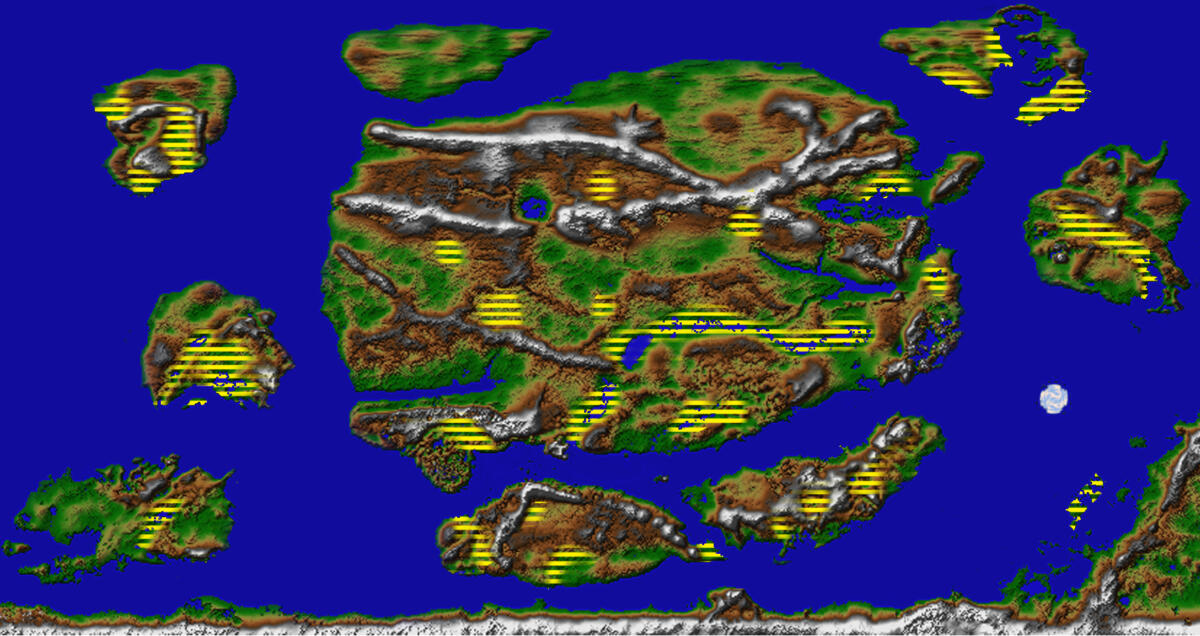
They are spread throughout the following Isles and Countries
Midgard: Ascal, Bebram, Ebrar, Gaslug, Kustu, Ladris, Mumak, Noriag, Sarova, Scia, Sloviit, Snaw, Spiy, Uhmzel, Zapri, Zilbur
West Fjella: Apal, Esly, Oglan
Findon: Andalus, Trevan, Ugren
Skjald Ulrich
Organisation
All pay allegiance to one great leader, but each tribe has its own local daily leader. The current ‘Great One’ is Hûar Harkwald.
They are a people living in peace with nature, spirits, and the flow of mana. They are forest and swamp folk, one of the most, if not the most, people in contact with nature and Fylgia. They live in small, secluded societies where the leader is generally Druid, or shaman.
They generally live in nudity or wear very little clothing, but wear a large amount of neclaces, armbands, earrings, fingerrings, etc., and leaves, flowers, vines, flowers, feathers, teeth, and beads are used for decoration. They don’t like to use footgear as it removes them from their contact with nature, a nature they dislike being destroyed or tampered with, so they defend it quite ferociously. It’s told that in their youth as a race, they continued the Neander habit of tearing down Asteal sites/gates erected by their ancestor’sl brethren, the Heidel. Resulting in a war among the two archaic sub-tribes.
Kanziganthir told me that some Moss’ari elders claim the Boriac told them to cease destroying the sites as they were vital to them. Thus, the war and tearing down ended.
Skjald El Mary
Since The Wanderers came and Ljostari sank beneath the sea, the Moss’ari have retracted deeper into the dense forests and remote mountain valleys spread out across the Realm and at Darin.
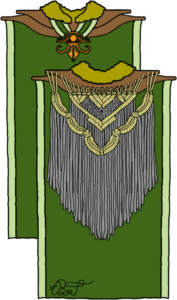
But when they go outside their settlements, for example, they travel to gatherings or surge out to defend theirs. They wear great capes of wool with wooden shoulders and elaborate knitting unique to each family. I suspect that the patterns have a deeper meaning, but no Moss’ari has explained it in depth yet.
It seems to me, though, from what I have managed to hear and observe, that the visibility of the family member in front of other Moss’ari somehow gains community fame. Thus inspiring others to act more ferociously towards the enemy.
Skjald Yell'a'Beard
Military
They are surely a sight when they go to war, body painted to look like birch bark, enhancing their shoulder width, and wearing great nut-shaped helmets with oddly large bulging and betted eyes and mouths. Normally, they are nude or very lightly armoured. Some melee units occasionally wear greaves and bracers of thick bark and Ironthorn branches.
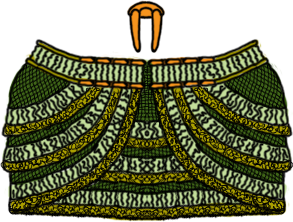
Their armies or warbands are seldom led by the tribe’s leader, but most often by non-magic-using warlords. Skilled in the art of warfare, having an occasional Mana Manipulator or two tagging along. The only metal they use are the rare Ljosti Bronze fittings for the Magic Glass tips, blades, and spikes on their richly engraved Ironthorn weapon shafts.
One thing one may also notice is that military ranks are displayed by the number of separate edges on the skirt.
When they go into war, it’s mostly on foot, but at times they are seen mounted onLjostari Elk or Unicorn
Skjald Vinotis
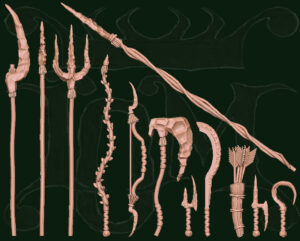
Their weapons are generally made of the exceptionally strong Ironthorn, fitted with magic glass. They use a variety of weapon types but generally go for slicing or puncturing weapons, delivering wounds that allow the often applied Poisons to take hold and spread among their opponents.
The Magic Glass also seems to have a Mana Flow freezing effect, disabling a mana manipulator from using his magic paths properly.
Skjald Sigurd
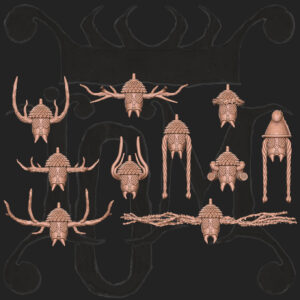
Aside from their weapons, skirts, and capes, they use helmets carved from huge Ironthorn seeds, shaped somewhat in the image of a wasp or ant. With all kinds of antlers, Ironthorn branches, horns, ropes, and more attached to add to the odd looks and distinguish unit type.
These masks are also sheltering them from Mentalism attacks.
Skjald El Mary
Special
They are almost immune to mentalism magic and are often accompanied by small Animals.
Skjald Sejrik
Last Updated on 2024-05-28 by IoM-Christian
